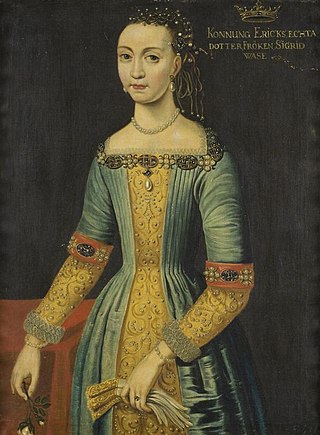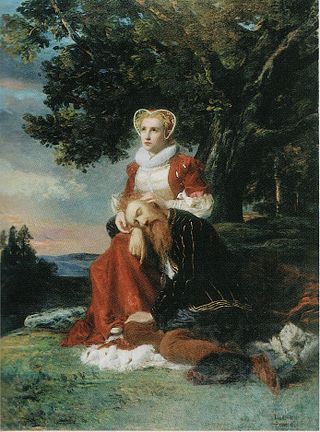Related Research Articles

Eric XIV was King of Sweden from 1560 until he was captured in a rebellion led by his brother John in 1568 and formally deposed 26 January 1569. Eric XIV was the eldest son of Gustav I (1496–1560) and Catherine of Saxe-Lauenburg (1513–1535). He was also ruler of Estonia, after it placed itself under Swedish protection in 1561.

Karin Månsdotter was first a mistress of King Eric XIV of Sweden and then briefly queen as his wife.

Catherine Jagiellon was a Polish–Lithuanian Commonwealth princess and Queen of Sweden from 1569 as the wife of King John III. Catherine had significant influence over state affairs during the reign of her spouse. She negotiated with the pope to introduce Counter-Reformation in Sweden. She was the mother of Sigismund, King of Poland (1587-1632) and Sweden (1592-1599).

Catherine Stenbock was Queen of Sweden from 1552 to 1560 as the third and last wife of King Gustav I.

Katarina "Karin" Hansdotter (1539–1596) was the royal mistress of King John III of Sweden during his time as Prince and Duke of Finland in 1555–1562.
Jöran Persson, alternatively Göran Persson, was King Eric XIV of Sweden's favorite, most trusted counsellor and head of the King's network of spies. He was widely seen as a Machiavellian figure, and as holding too much influence over Eric. On both occasions on which the King was removed from power, Persson was quickly arrested by the nobility; the second time he was executed shortly after his arrest.

Renata of Lorraine was a French noblewoman of the House of Lorraine who became a Duchess of Bavaria by her marriage to Duke William V.

Princess Sophia of Sweden, also Sofia Gustavsdotter Vasa, was a Swedish princess, daughter of King Gustav Vasa of Sweden and Margareta Leijonhufvud. She was formally Duchess consort of Saxe-Lauenburg by her marriage to Duke Magnus II of Saxe-Lauenburg.

Sigrid Eriksdotter of Sweden was a Swedish princess, the legitimized daughter of King Eric XIV of Sweden and of his lover, later spouse and queen, Karin Månsdotter.
Martha Eriksdotter Leijonhufvud, known as Kung Märta, was a politically-active Swedish noblewoman. She was the sister of Queen Margaret Leijonhufvud and sister-in-law of King Gustav I of Sweden: she was also the maternal aunt of Queen Catherine Stenbock and the daughter-in-law of the regent Christina Gyllenstierna. In 1568, she financed the deposition of King Eric XIV of Sweden, which placed her nephew John III of Sweden on the throne.

The Sture murders in Uppsala, Sweden, of 24 May 1567, were the murders of five incarcerated Swedish nobles by Erik XIV of Sweden, who at that time was in a state of serious mental disorder, and his guards. The nobles, among them three members of the influential Sture family, had been charged with conspiracy against the king and some were previously sentenced to death. Erik's old tutor, who did not belong to this group, was also killed when he tried to calm the king after the initial murders.
Geert van Wou was a well-known Dutch bellfounder. He is best known today for the Maria Gloriosa (1497) of Erfurt Cathedral. The son of a bellfounder, he is considered one of the most important bellfounders of the Middle Ages, though records suggest he participated in other casting.
Valborg Eriksdotter (1545-1580), was the royal mistress of Magnus, Duke of Östergötland, between 1560 and 1567. She was the only official mistress of Magnus with the exception of Anna von Haugwitz. She was the mother of the acknowledged illegitimate daughter of Magnus, Lucretia Magnusdotter (Gyllenhielm).
Elin Andersdotter, was a Swedish courtier. She served as Chief Court Mistress to queen Karin Månsdotter of Sweden. She is known for being a leading actor in the 1569 Plot to free and reinstate the imprisoned and deposed king Erik XIV of Sweden.
Anna Andersdotter, was a Swedish noble, married to the Jöran Persson, the adviser of King Eric XIV of Sweden.
Dorothea Ostrelska also known as Dosieczka, Doska and Dvärginnan Dorothea, was a Polish Court dwarf in service of the queen of Sweden, Catherine Jagiellon.

Events from the year 1567 in Sweden

The following events occurred in the year 1568 in Sweden.
Eriksdotter may refer to:
The 1569 Plot was a conspiracy in Sweden in 1569. The purpose was to depose John III of Sweden and reinstate the imprisoned Eric XIV of Sweden on the Swedish throne. The plot was instigated by the courtiers of Eric's spouse queen Karin Månsdotter; her lady-in-waiting Elin Andersdotter and her personal secretary Thomas Jakobsson. It was the first of three major plots to free the imprisoned Eric XIV, but has been described as the most serious one. The plot was exposed and prevented before it could be put in action and resulted in the execution of the conspirators.